Books
Books

Postsensual Aesthetics: on the logic of the curatorial
In this original work of aesthetic theory, James Voorhies argues that we live in the shadow of old ways of thinking about art that emphasize the immediate visual experience of an autonomous art object. But theory must change as artistic and curatorial production has changed. It should encompass the full range of activities through which we encounter art and exhibitions, in which reading and thinking are central to the aesthetic experience. Voorhies advances the theoretical framework of a "postsensual aesthetics," which does not mean we are beyond a sensual engagement with objects, but rather embraces the cognitive connections with ideas that unite art and knowledge production. Cognitive engagements with art often begin with publications conceived as integral to exhibitions, conveying the knowledge and research artists and curators produce, and continuing in time and space beyond traditional curatorial frames. The idea, and not just visual immediacy, is now art's defining moment.
Voorhies reframes aesthetic criteria to account for the liminal, cognitive spaces inside and outside of the exhibition. Surveying a wide range of artists, curators, exhibitions, and related publications, he repositions the aesthetic theory of Theodor Adorno, and draws inspiration from Rosalind Krauss and Fredric Jameson, to describe a contemporary "logic of the curatorial." He demonstrates how, even as we increasingly expect to learn from contemporary art, we must avoid an instrumentalist and reductive view of art as a mere source of information. As Voorhies shows through an analysis of two major global exhibitions, dOCUMENTA (13) (artistic director Carolyn Christov-Bakargiev) and Documenta11 (artistic director Okwui Enwezor), and of Ute Meta Bauer's curatorial work at the Centre for Contemporary Art Singapore, it is imperative for artistic research to retain its unique role in the production of knowledge.

Studio Visit
Studio Visit collects two decades of work by Brooklyn-based artist Sara Greenberger Rafferty (born 1978), known for her material transformation of photographs and her use of comedy as an artistic strategy. Organized by material sensibilities around paper, plastic, glass, metal, fabric scraps, and "garbage," Studio Visit rethinks the monograph format, revealing Sara Greenberger Rafferty’s practice through intimate studio documentation, sketches, notes, and other ephemera, punctuated by full-color case studies of major works.
With image descriptions by art historian Kate Nesin and new writing by Kristan Kennedy and Oscar Bedford, as well as reprinted texts by poet Lisa Robertson and media scholar Shannon Mattern, among others, Studio Visitsurveys Sara Greenberger Rafferty's cultural commentary through dynamic and conceptually rigorous art.
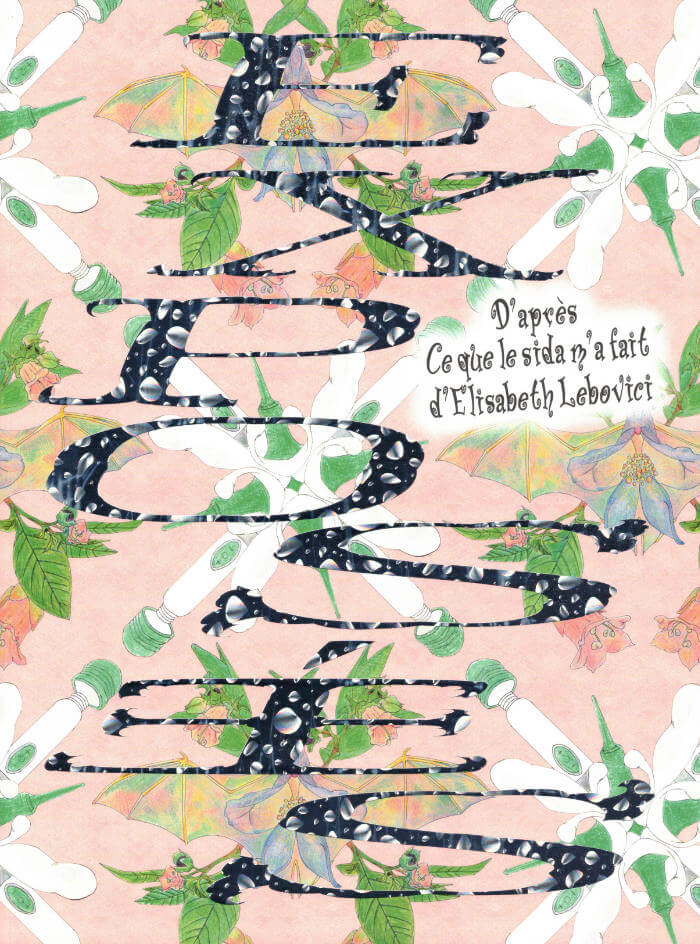
Exposé-es : d'après Ce que le sida m'a fait d'Elisabeth Lebovici
Fonds Mercator, Palais de Tokyo
Ce catalogue qui accompagne l’exposition Exposé·es ne se divise pas en chapitres, mais entrelace les genres et les modalités d’écriture et de documentation, avec des formats variés. Il comprend notamment une multitude de courts entretiens ou écrits autour des pratiques des artistes et de personnes concernées, des essais commandés à des auteur·rices et des séquences d’images, représentant les travaux des artistes de l’exposition, ou documentant des projets artistiques qui ont eu lieu historiquement dans le contexte de ces luttes.
Avec les artistes : Les Ami·es du Patchwork des noms, Bambanani Women’s Group, Bastille, yann beauvais, Black Audio Film Collective, Gregg Bordowitz, Jesse Darling, Moyra Davey, Guillaume Dustan, fierce pussy (Nancy Brooks Brody, Joy Episalla, Zoe Leonard, Carrie Yamaoka), Nan Goldin, Felix Gonzalez-Torres, Hervé Guibert, Barbara Hammer, Derek Jarman, Michel Journiac, Zoe Leonard, audrey liebot, Pascal Lièvre, Santu Mofokeng, Jean-Luc Moulène, Henrik Olesen, Bruno Pélassy, Benoît Piéron, Lili Reynaud-Dewar, Jimmy Robert, Régis Samba-Kounzi & Julien Devemy, Marion Scemama, Lionel Soukaz & Stéphane Gérard, Georges Tony Stoll, Philippe Thomas, David Wojnarowicz
Et les auteur·ices : Clémence Allezard, Cécile Chartrain, Vinciane Despret, Mylène Ferrand, Amandine Gay, Philippe Joanny, Elisabeth Lebovici, Nicolas Linnert, Sylvère Lotringer, Tim Madesclaire, Helen Molesworth, Veronica Noseda, Peggy Pierrot, François Piron, Donald Rodney, Jane Solomon, Jo-ey Tang, Gaëtan Thomas
Design graphique : Roxanne Maillet
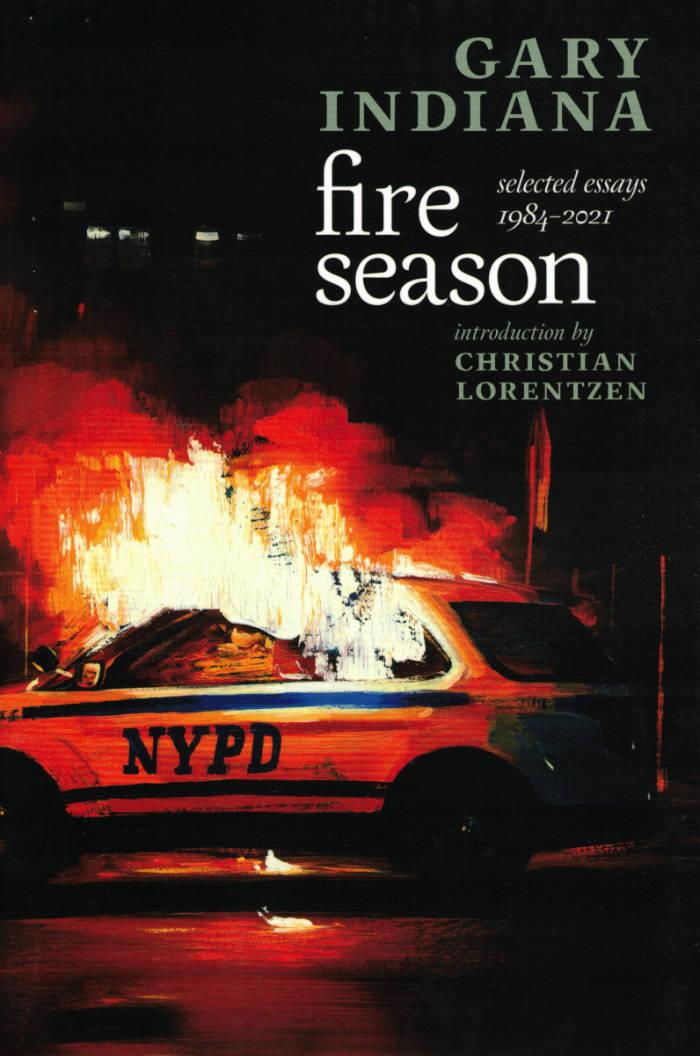
Fire Season: Selected Essays 1984-2021
Whether he's describing Tracy Emin or Warhol, the films of Barbet Schroeder ("Schroeder is well aware that life is not a narrative; that we impose form on the movements of chance, contingency, and impulse....") or the installations of Barbara Kruger ("Kruger compresses the telling exchanges of lived experience that betray how skewed our lives are..."), Indiana is never just describing.
Indiana champions shining examples of literary and artistic merit regardless of whether the individual artist or writer is famous; asserts a standard of care and tradition that has nothing to do with the ivory tower establishment; is unafraid to deliver the coup de grãace when someone needs to say the emperor has no clothes; speaks in the same breath-in the same discerning, insolent, eloquent way-about high art and pop culture. Few writers could get away with saying the things Gary Indiana does. And when the writing is this good, it's also political, plus it's a riot of fun on the page
GARY INDIANA is a novelist and critic who has chronicled the despair and hysteria of America in the late twentieth/early twenty-first century. From Horse Crazy (1989), a tale of feverish love set against the backdrop of downtown New York amid the AIDS epidemic, to Do Everything in the Dark (2003), "a desolate frieze of New York's aging bohemians" ( n+1), Indiana's novels mix horror and bathos, grim social commentary with passages of tenderest, frailest desire. In 2015, Indiana published his acclaimed anti-memoir, I Can Give You Anything But Love, following it up in 2018 with Vile Days, a collection of his art criticism for the Village Voice. Called one of "the most brilliant critics writing in America today" by the London Review of Books, "the punk poet and pillar of lower-Manhattan society" by Jamaica Kincaid, and "one of the most important chroniclers of the modern psyche" by the Guardian, Gary Indiana remains both inimitable and impossible to pin down.

We Want Everything
It was 1969, and temperatures were rising across the factories of the north as workers demanded better pay and conditions. Soon, discontent would erupt in what became known as Italy’s Hot Autumn. A young worker from the impoverished south arrives at Fiat’s Mirafiori factory in Turin, where his darker complexion begins to fade from the fourteen-hour workdays in sweltering industrial heat. His bosses try to withhold his wages. Our cynical, dry-witted narrator will not bend to their will. “I want everything, everything that’s owed to me,” he tells them. “Nothing more and nothing less, because you don’t mess with me.”
Around him, students are holding secret meetings and union workers begin halting work on the assembly lines, crippling the Mirafiori factory with months of continuous strikes. Before long, barricades line the roads, tear gas wafts into private homes, and the slogan “We Want Everything” is ringing through the streets.
Wrought in spare and measured prose, Balestrini’s novel depicts an explosive uprising. Introduced by Rachel Kushner, the author of the best-selling The Flamethrowers, We Want Everything is the incendiary fictional account of events that led to a decade of revolt.
Translated by Matt Holden
Introduction by Rachel Kushner
-575f5a59fae756755c70e16a3f1db7f4.jpg)
The Black Atlantic
In this groundbreaking work, Paul Gilroy proposes that the modern black experience can not be defined solely as African, American, Carribean or British alone, but can only be understand as a Black Atlantic culture that transcends ethnicity or nationality. This culture is thorough modern and, often, overlooked but can deeply enriches our understanding of what it means to be modern.
This condition comes out of historical transoceanic experience, established first with the slave trade but later seen in the development of a transatlantic culture. And Gilroy takes us on a tour of the music that, for centuries, has transmitted racial messages and feeling around the world, from the Jubilee Singers in the nineteenth century to Jimi Hendrix to rap. He also explores this internationalism as it is manifested in black writing from the ‘double consciousness’ of W. E. B. Du Bois to the ‘double vision’ of Richard Wright to the compelling voice of Toni Morrison. As a consequence, Black Atlantic charts the formation of a nationalism, if not a nation, within this shared, disasporic culture.
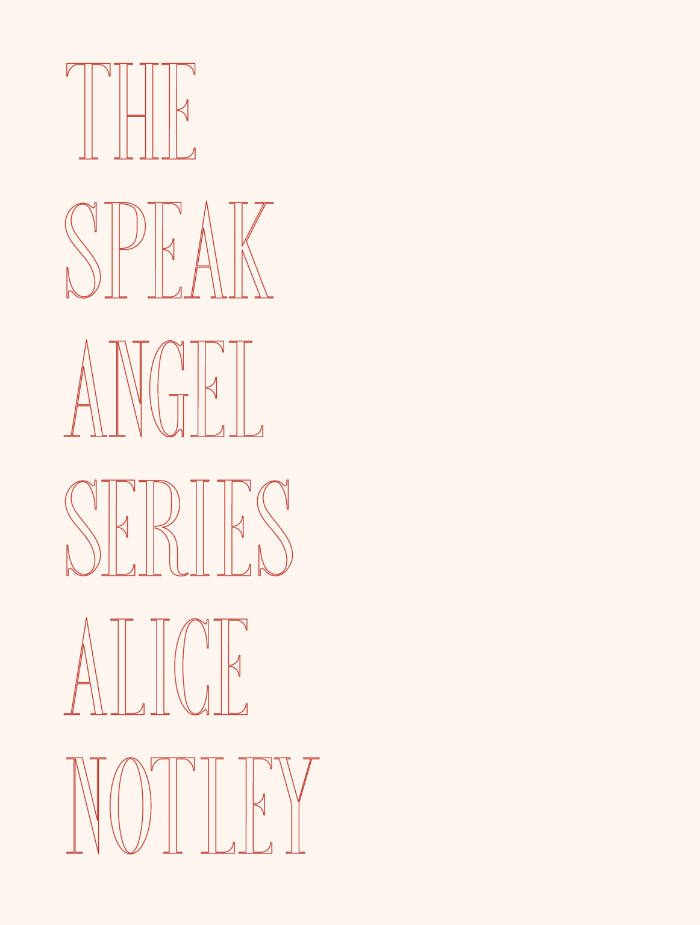
The Speak Angel Series
The Speak Angel Series is composed of six full-length books in various forms but towards the achievement of a unifying epic narrative in which the poet, as character, leads all the souls of all the living and dead to a point zero where the remaking of the cosmos can be performed. As this is being done, the official public world takes place in Paris, France and the United States, and new “characters” are incorporated from the news and from the poet’s life.
The forms include a long-line narrative broken by lyric stand-alones, an operatic form designed to make the reader chant if reading aloud, two spiritual sequels to the author’s book The Descent of Alette, written in the same stanzaic form, a book that is simply a collection of different kinds of poems, a book formed by literary collaging, and a final, long book that is the volume’s ultimate culmination.
The Speak Angel Series took years to accomplish but is finally ready; it is meant to be read for plot, pleasure, musical experience, wisdom and truth. Why not? The books present something like a cosmology in the philosophical sense, a reading of existence and of death. The dead are very close-by and available in the series, which is a work of stunning ambition.
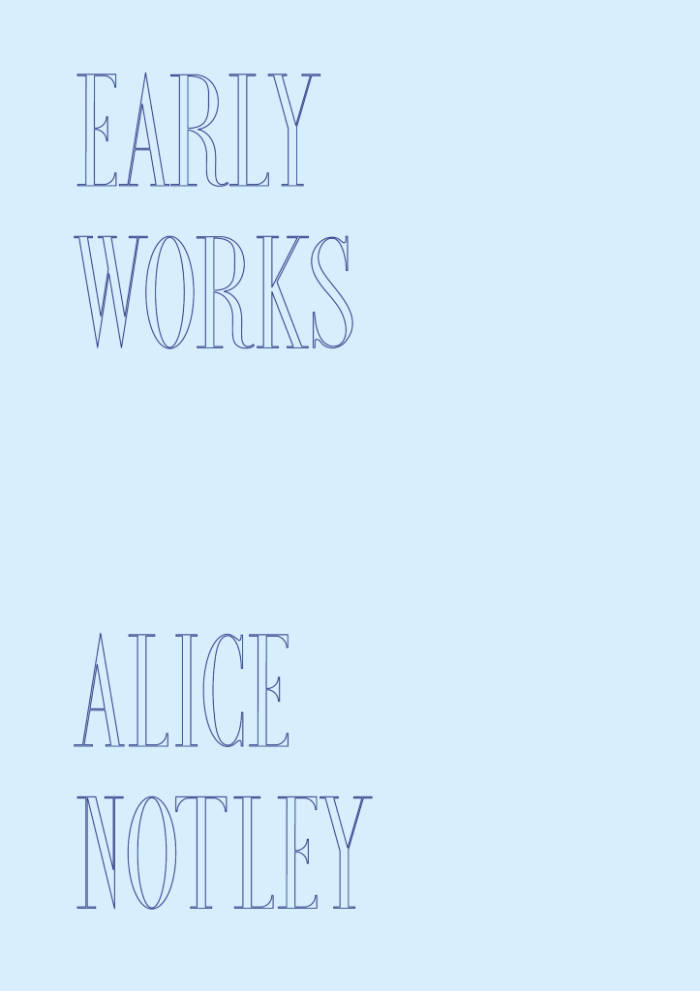
Early Works
Early Works collects Alice Notley’s first four out of print poetry collections, along with 80 pages of previously uncollected material. A must have for any Notley fan. Includes original collection cover artwork by Philip Guston, Philip Whalen and George Schneeman, among others.
From editor Nick Sturm’s “Introduction” to Early Works:
In the author’s note that begins Grave of Light: New and Selected Poems 1970-2005, Alice Notley writes, “My publishing history is awkward and untidy, though colorful and even beautiful.” I have always been enamored of this sentence, which reminds us that an array of dispersed and varying publishing contexts are the original sites that give shape to such a book’s form. It is also something of an invitation into that color and untidiness, a prompt to become more curious about the awkwardness and beauty of Notley’s publishing history. This book, Early Works, accounts for a significant portion of that history by bringing back into print the complete versions of her first four books, a little-known 22-poem sonnet sequence, and a large selection of early uncollected poems gathered from little magazines. In doing so, Early Works joins an important set of recent volumes that put Notley’s earlier poetry back into circulation, including Manhattan Luck (Hearts Desire, 2014), which collects four long poems written between 1978 and 1984, and Songs for the Unborn Second Baby, originally published by United Artists in 1979 and reissued in a facsimile edition by London-based Distance No Object in 2021. Each in their own way, and especially taken together, these books continue to confirm that, as Ted Berrigan writes in The Poetry Project Newsletter in 1981, “Alice Notley is even better than anyone has yet said she is.”
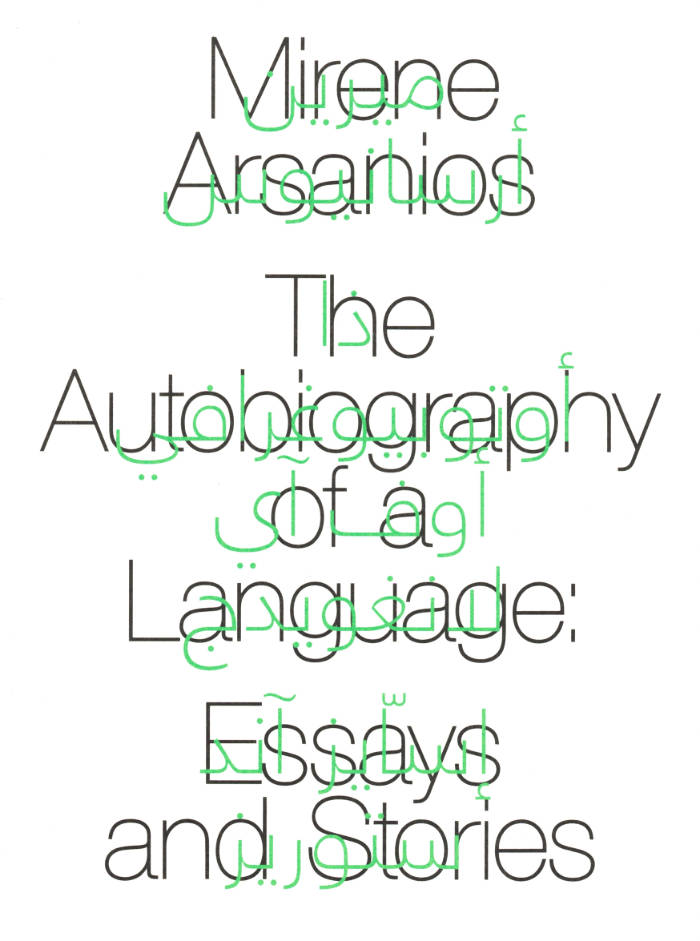
The Autobiography of a Language
Here the mirror image of the almost hallucinatory, heart-rending loss of the familiar is literary defamiliarization. Arsanios both mourns and blasts apart the notion of the mother tongue, reminding us that for each “mother tongue” at least another tongue is silenced. Desire propels her genre-defying writing, which grief notwithstanding still manages to tongue languages, and that is her genius. — Mónica de la Torre
Mirene Arsanios is the author of the short story collection The City Outside the Sentence (Ashkal Alwan). She has contributed essays and short stories to e-flux journal, Vida, The Brooklyn Rail, The Rumpus, and Guernica, among others. Arsanios co-founded the collective 98weeks Research Project in Beirut and is the founding editor of Makhzin, a bilingual English/Arabic magazine for innovative writing. She teaches at Pratt Institute and holds an MFA in Writing from the Milton Avery Graduate School for the Arts at Bard College. Arsanios currently lives in New York where she was a 2016 LMCC Workspace fellow, and an ART OMI resident in fall 2017. With Rachel Valinsky, she coordinated the Friday night reading series at the Poetry Project from 2017–19.

Lagoon
Part prose poem, part reflection on the relations between writing and place, Lagoon tells the story of the slow undoing of an idyll. In it the narrator walks for hours during long summer nights, gazing through the windows that line the streets. In between, she reflects on how she might write about the shifting space of the lagoon, where she spent summer holidays with her family years ago. In adolescence, the narrator watches quietly as her mother, father and sister go about building their holiday home. But she can sense something is awry, she just does not fully understand what.
Lagoon is the first novella by McCulloch.
Lagoon by Samantha McCulloch is the first title in Kunstverein Amsterdam's new imprint called First Drafts, which, inspired by artist and publisher Anne Turyn, celebrates experimental and commercially unviable work by publishing completed manuscripts that haven’t yet found a home in their first draft form. Importantly, each title is also the first attempt by the author to write in that particular form, or, to write at all.
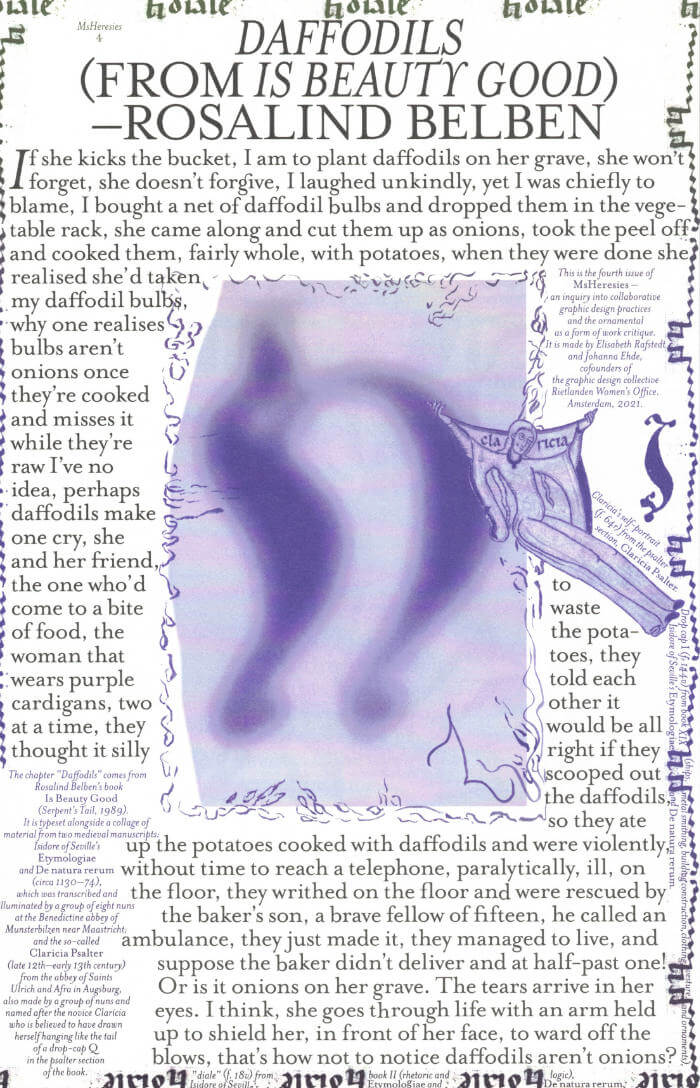
MsHeresies 4 — Daffodils
Elisabeth Rafstedt, Johanna Ehde
This fourth issue of MsHeresies republishes the chapter *Daffodils* — a warped monologue about a domestic poisoning — from Rosalind Belben’s book Is Beauty Good (1989).
It is typeset alongside a collage of material from two medieval manuscripts: Isidore of Seville’s Etymologiae and De natura rerum (circa 1130–74), which was illuminated and transcribed by a group of eight nuns at the Benedictine abbey of Munsterbilzen in Maastricht; and the so called Claricia Psalter (late 12th–early 13th century) from the abbey of saints Ulrich and Afra in Augsberg, also made by a group of nuns and named after the novice Claricia who is believed to have drawn herself hanging like the tail of a drop-cap Q in the psalter section of the book.
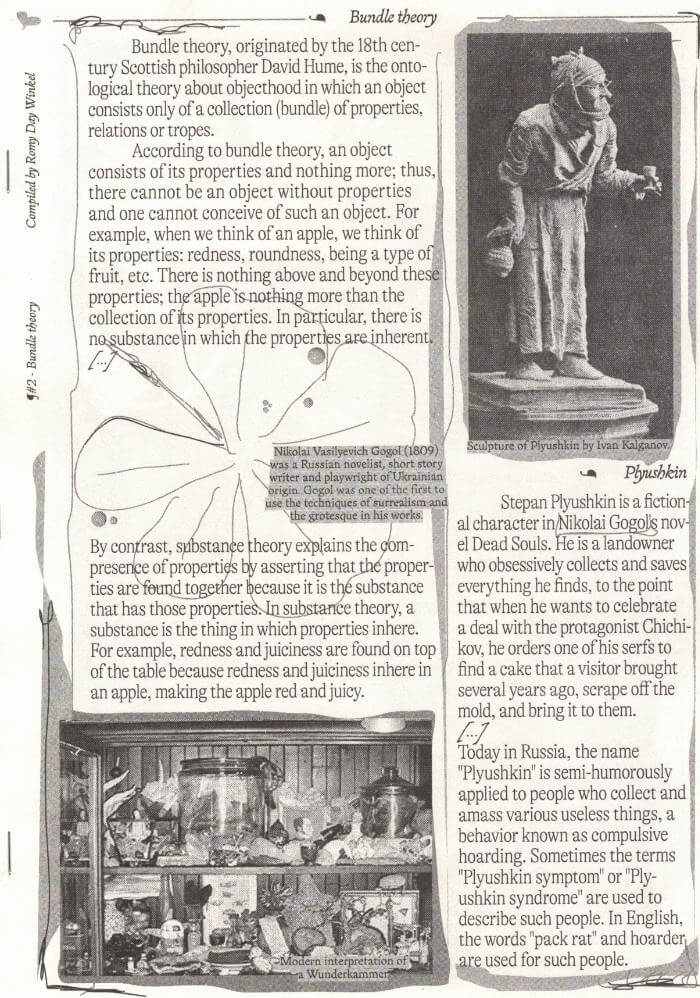
¶#2: Bundle theory
For #2 in the ¶ (Pilcrow)-series Romy Day Winkel has approached collecting, or hoarding, as an aesthetic of patience. Through her selection of Wikipedia-articles she looks at what happens when objects, magical or otherwise, are all put together. If it is impossible, and perhaps even uninteresting, to know when a collection or archive is finished, how does one start to hoard impatiently
¶#2 consists solely of texts and images found on the online collaborative platform Wikipedia. ¶#2 is assembled by Romy Day Winkel, designed by Tjobo Kho and Wouter Stroet, edited by Jan-Pieter ‘t Hart and published by OUTLINE.

¶#3: The mental traveller
¶#3 consists of texts and images found on the online collaborative encyclopedia Wikipedia, BIC pen drawings by Kim David Bots and the poem The Mental Traveller by William Blake. ¶#3 is assembled by Kim David Bots, designed by Tjobo Kho, edited by Jan-Pieter ‘t Hart and published in an edition of 150 by OUTLINE in May 2022.

Women Looking at Women Looking at Women
In what ways have women artists come together to investigate their own image? This publication delves into histories of feminist and queer collective practice, expanding on the various ways women claim agency of their identity, via collaborations that connect intergenerational and far-away friendships. Each chapter features artistic and theoretical case studies that discuss images produced by women artists, about women artists; proposing that to gaze upon someone represented with care and autonomy provides more affirmative ways to relate to ourselves. It discovers that to pay homage to overlooked knowledge of women artists builds a case for the artist as researcher. Only by engaging in both roles can we unveil what is not taught in the mainstream and inspire a more inclusive, generous future.
Each aspect of the book’s design is a collaborative endeavour, expanding the notion of individual authorship. It is with this sentiment that creating the publication became research in itself, via collaboration with both direct peers and an extended genealogy.
“Women Looking at Women Looking at Women” is designed by Marijn van der Leeuw, Esther Vane, India Scrimgeour, Hannah Williams and Annemarie Wadlow.
Annemarie Wadlow (1993, UK) is a research-led artist working between moving image, writing and photography. Her work explores the middle ground between image and imagination, questioning notions of inheritance, personal identity and belonging. She is the co-founder of Nice Flaps, an artist initiative that hosts experimental life drawing sessions.

Studies on Fantasmical Anatomies
Studies on Fantasmical Anatomies is an ongoing transdisciplinary artistic research, which encompasses the spectrum of experiences and practices that Anne Juren has developed as a choreographer, dancer and Feldenkrais practitioner. Her interest in anatomy and somatic practices grew out of multiple shoulder dislocations. The last dislocation happened in 2014 and, in retrospect, it functioned as a catalyst for this PhD and as one of its main methodologies. With the notion of “anatomies”, the interest sits more in operations on the body, than defining the body itself.

Raving
McKenzie Wark takes readers into the undisclosed locations of New York's thriving queer rave scene, showing how raving to techno is an art and technique at which queer and trans bodies might be particularly adept, but which is for anyone who lets the beat seduce them.
Contents
1. Rave as Practice
2. Xeno-euphoria
3. Ketamine Femmunism
4. Enlustment
5. Resonant Abstraction
6. Excessive Machine
"How to write a book about raving as a practice that practices rave? From k-nights spent on Brooklyn's and Berlin's junkspace dance floors, McKenzie Wark abstracts a life practice of ressociation in a dance of autoconceptualization and allotheorization. In crossing toward the stranger's gift of 'letting go of ourselves as private property, ' Raving is nothing less than Wark's femmunist manifesto, her tractatus on techno's blackness, her treatise for a twenty-first-century trans ethics."—Kodwo Eshun
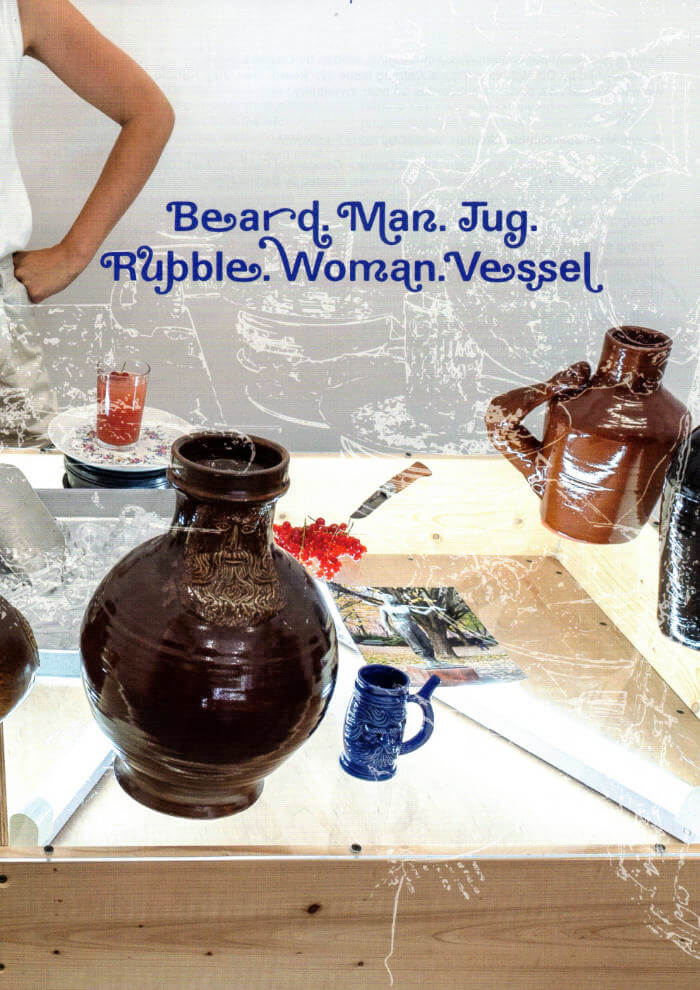
Catalog Issue 22 — 'Beard. Man. Jug. Rubble. Woman. Vessel.'
Catalog is a serial publication about cataloging, written by Lieven Lahaye and designed by Ott Metusala. This is Catalog issue 22, 'Beard. Man. Jug. Rubble. Woman. Vessel', it's part of a sub-series on near invisibility.

Dear Friend Catalogue 2019-2022
Dear Friend is a monthly letter format publication covering design events, issues, and ideas. This publication distributed via snail mail is initiated by Sandra Nuut and Ott Kagovere.
The publication edited by Sandra Nuut & Ott Kagovere features all the letters from the Dear Friend publishing project, which they initiated at the Graphic Design Department of the Estonian Academy of Arts in 2018. The book includes contributions by Singapore-based design writer Justin Zhuang, designer and writer Else Lagerspetz, and artist Lieven Lahaye. The book is designed by Ott Kagovere and published by Lugemik and Estonian Academy of Arts.
Texts by Justin Zhuang, Lieven Lahaye, Else Lagerspetz
Letters written by Alicia Ajayi, Stuart Bertolotti-Bailey, Claudia Doms, Nell Donkers, Maarin Ektermann, Rosen Eveleigh, Maryam Fanni, Saara Hannus, Eik Hermann, Paul John, Maria Juur, Ott Kagovere, Maarja Kangro, Arja Karhumaa, Kristina Ketola Bore, Nicole Killian, Rachel Kinbar, Tuomas Kortteinen, Keiu Krikmann, Kadri Laas, Else Lagerspetz, Lieven Lahaye, James Langdon, Jungmyung Lee, Kai Lobjakas, Michelle Millar Fisher, Maria Muuk, Sheere Ng, Sandra Nuut, Laura Pappa, Jack Self, Indrek Sirkel, Paul Soulellis, Triin Tamm, Laura Toots, Alice Twemlow, Loore Viires, Sean Yendrys, Justin Zhuang
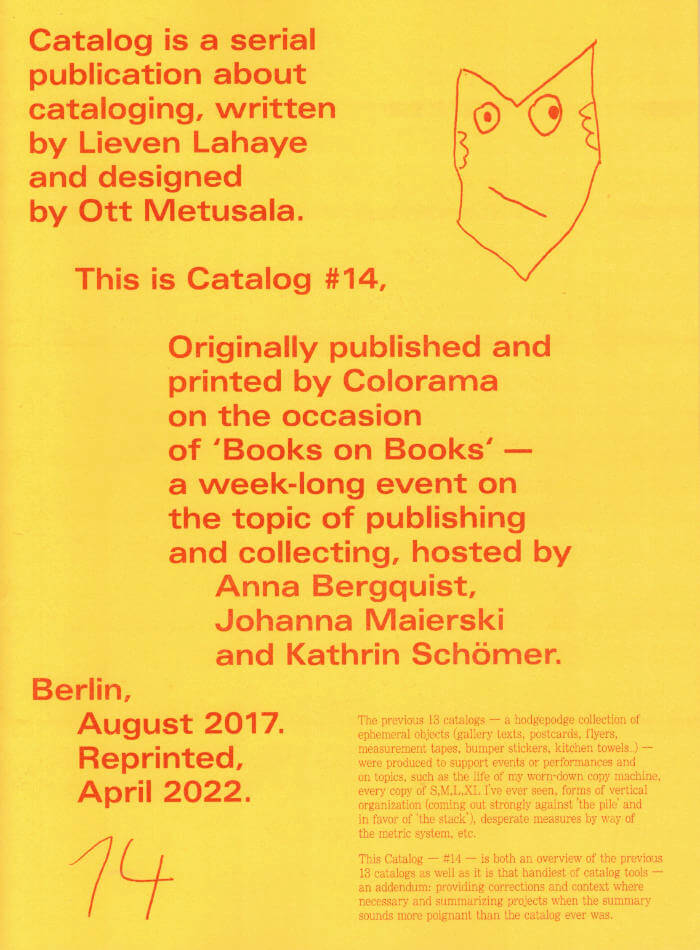
Catalog Issue 14 — 'Books on Books'
Catalog is a serial publication about cataloging, written by Lieven Lahaye and designed by Ott Metusala. This is Catalog #14, printed by Colorama on the occasion of ‘Books on Books’ — a week-long event on the topic of publishing and collecting, hosted by Anna Bergquist, Johanna Maierski and Kathrin Schömer. Berlin, August 2017.
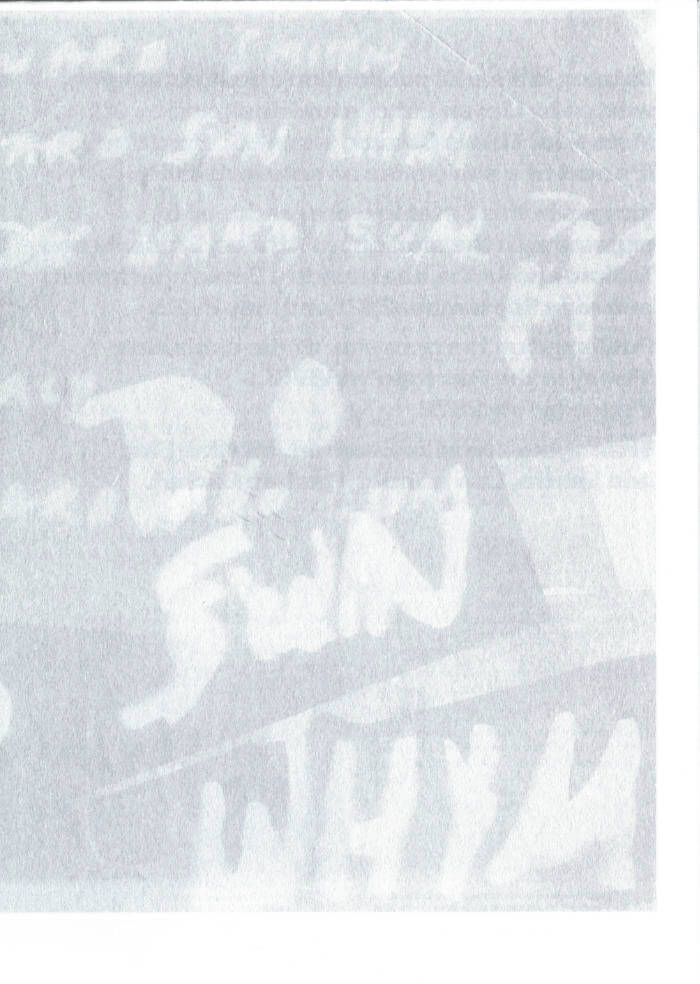
Catalog Issue 20 — 'Hard Sun'
Catalog is a serial publication about cataloging, written by Lieven Lahaye and designed by Ott Metusala. This is Catalog issue 20, ‘Hard Sun’, it’s part of a sub-series on near invisibility. Images in this Catalog were produced by exposure: to the sunlight of Athens, Brussels and Tallinn, and to the heat inside a Berlin apartment, between September 2021 and May 2022. Published on the occasion of the exhibition ‘Penny in the Fountain’ at VBKÖ, Vienna in July 2022.

Catalog Issue 21 — 'Impressed'
Catalog is a serial publication about cataloging written by Lieven Lahaye and designed by Ott Metusala. This is Catalog issue 21, ‘Impressed’, it’s part of a sub-series on near invisibility. Published on the occasion of the exhibition ‘Dear Friend’ at EKA Gallery, Tallinn in September 2022. This issue of Catalog was produced during a residency period at Air Berlin Alexanderplatz, May-August 2022.
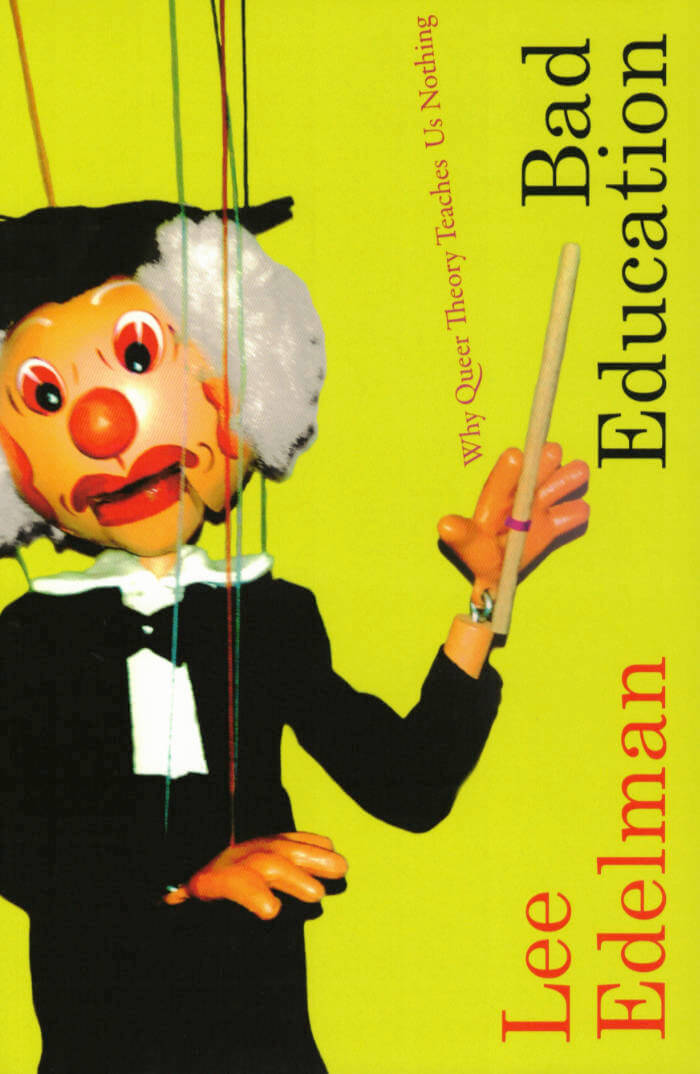
Bad Education: Why Queer Theory Teaches Us Nothing
Long awaited after No Future, and making queer theory controversial again, Lee Edelman’s Bad Education proposes a queerness without positive identity—a queerness understood as a figural name for the void, itself unnamable, around which the social order takes shape.
Like Blackness, woman, incest, and sex, queerness, as Edelman explains it, designates the antagonism, the structuring negativity, preventing that order from achieving coherence. But when certain types of persons get read as literalizing queerness, the negation of their negativity can seem to resolve the social antagonism and totalize community.
By translating the nothing of queerness into the something of “the queer,” the order of meaning defends against the senselessness that undoes it, thus mirroring, Edelman argues, education’s response to queerness: its sublimation of irony into the meaningfulness of a world. Putting queerness in relation to Lacan’s “ab-sens” and in dialogue with feminist and Afropessimist thought, Edelman reads works by Shakespeare, Jacobs, Almodóvar, Lemmons, and Haneke, among others, to show why queer theory’s engagement with queerness necessarily results in a bad education that is destined to teach us nothing.
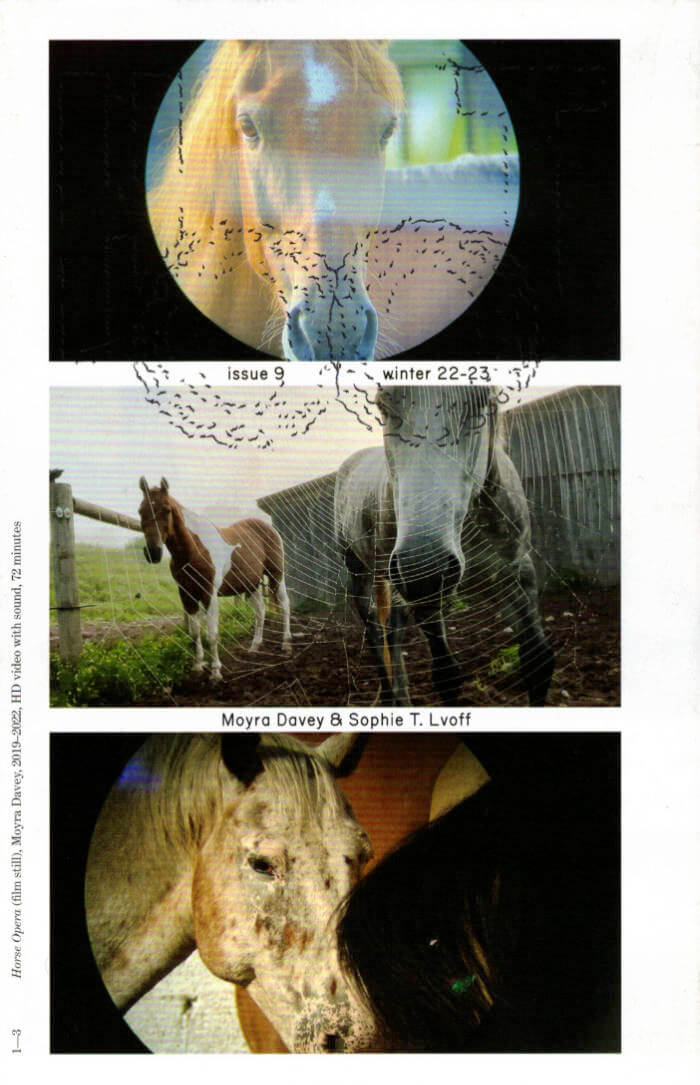
HOOT nr. 9 — Moyra Davey & Sophie T. Lvoff
The 9th HOOT pops up for the winter 2022-23, but the conception of this issue started well over a year ago at our beloved Plage Avant (Traduttore, traditore’s studio, Marseille).
We met Sophie T. Lvoff at many openings and art related events in Marseille these last few years, having a practice that appears mainly as photography, Gufo got curious about all the processes that she uses which involve sound, installation, writing… and more. She welcomed us in her studio of the city of Marseille where she recently settled.
We found out about the “trompe-l’œil” of this iconic checkered table, witnessed the installations of translucid and colored objects evolving on the sunny wall, and looked through her photographic chamber it’s called a large-format camera, but this is funny… For this issue, Sophie suggested to interview another artist, Moyra Davey, who also works in photography and writing, and appeared to have shared experiences too.
The topics of everyday life, intimacy that images embody in both their works, take another dimension as soon as their thoughts, voices and writing expand and express the entirety of their gestures.
This issue is the first interview between two native English-speaking artists, who have ties to the French language from childhood.
The penpals are the main characters of that encounter where we are very welcome to join in their very generous conversations. This is only an excerpt of a long and well referenced correspondence.

La Société n'existe pas: Images de la guerre civile sous Margaret Thatcher
« La société n’existe pas » : la formule de l’ancienne Première ministre britannique Margaret Thatcher est restée célèbre. On connaît moins ses ramifications en images, de la guerre civile anglaise du XVIIe siècle jusqu’à l’art contemporain en passant par la culture populaire en Grande-Bretagne. De photographies en affiches, de manuscrits en frontispices, ce livre traverse l’histoire pour cerner les échos visuels du thatchérisme. Son point de départ est une pièce de l’artiste Jeremy Deller : la reconstitution d’une bataille ouvrière entre mineurs grévistes et policiers survenue en 1984. Maxime Boidy en extrait une série de scènes qui sont autant d’infléchissements de l’idée de « corps politique ». Ce faisant, il dessine la discrète et brûlante actualité de ces formes symboliques, à l’heure de la guerre civile qu’a imposé le thatchérisme globalisé.
Maxime Boidy est enseignant-chercheur en études visuelles. Il s’intéresse principalement à l’histoire des savoirs de l’image et à l’iconographie politique sous toutes ses formes.